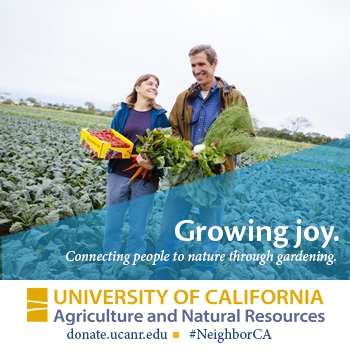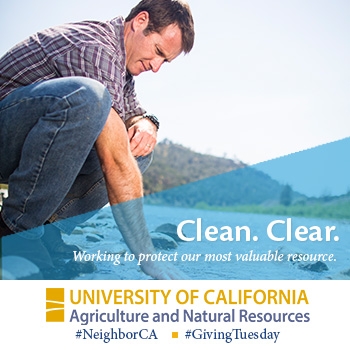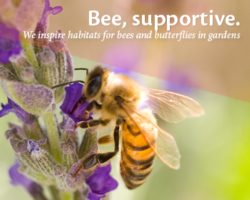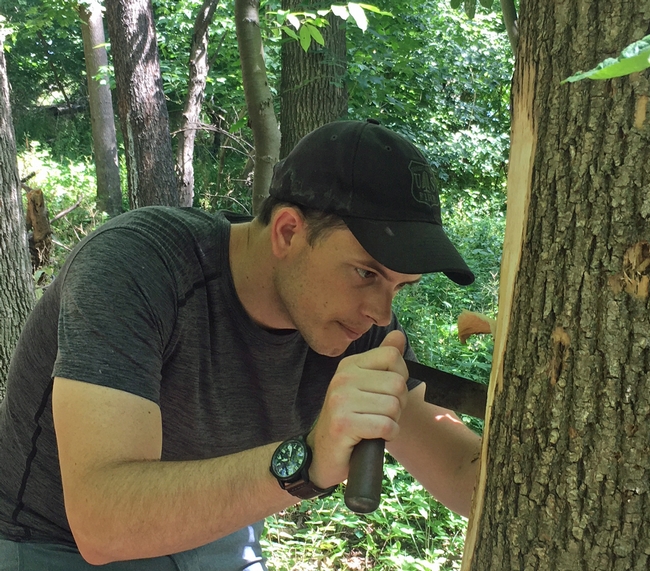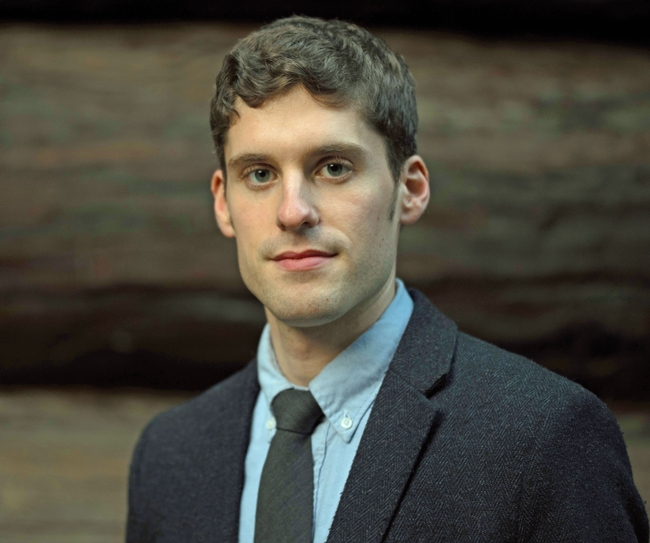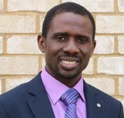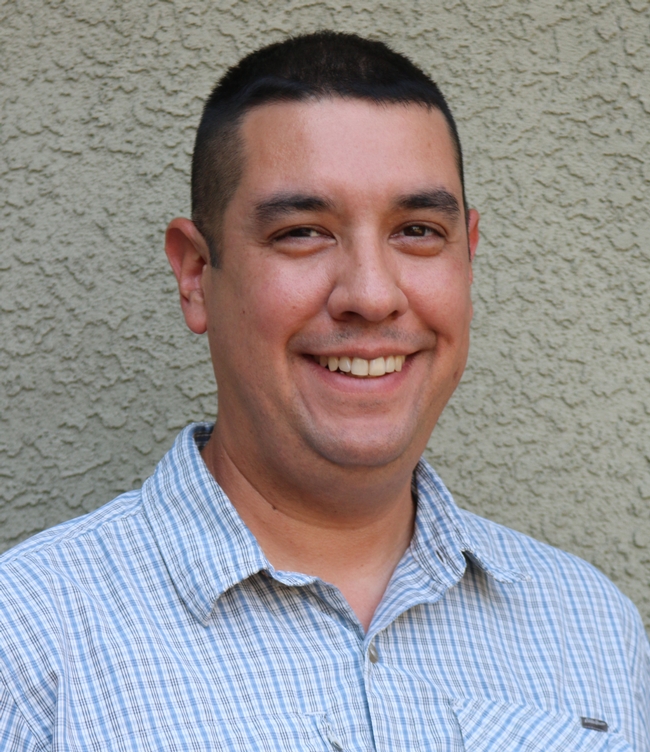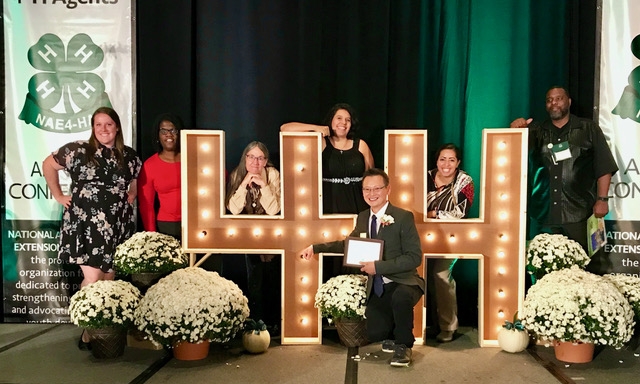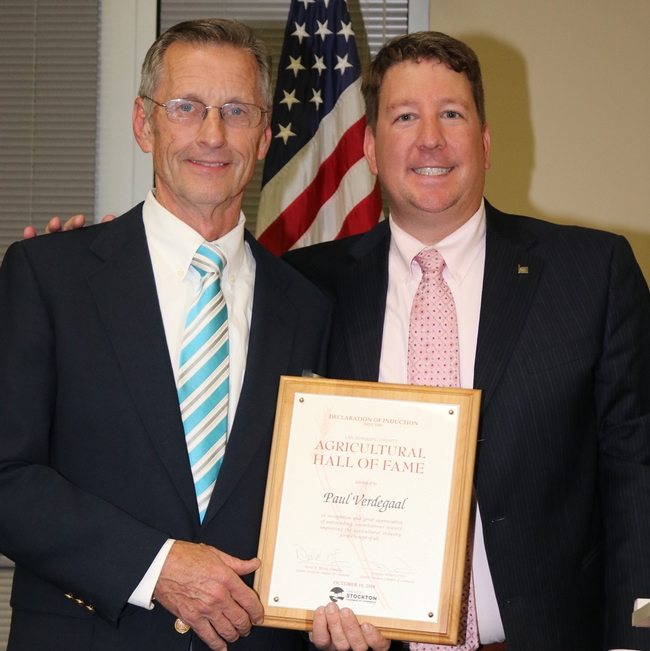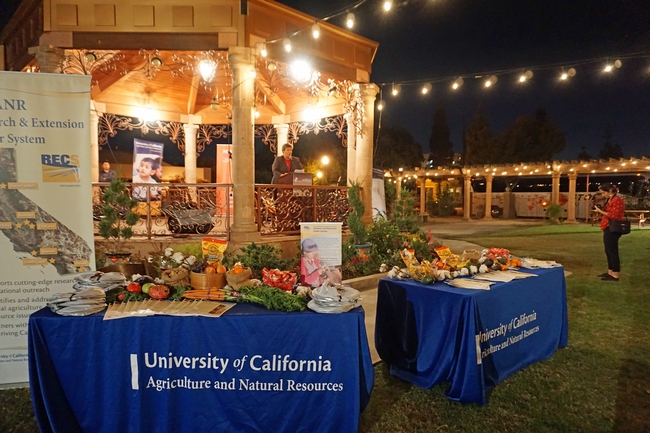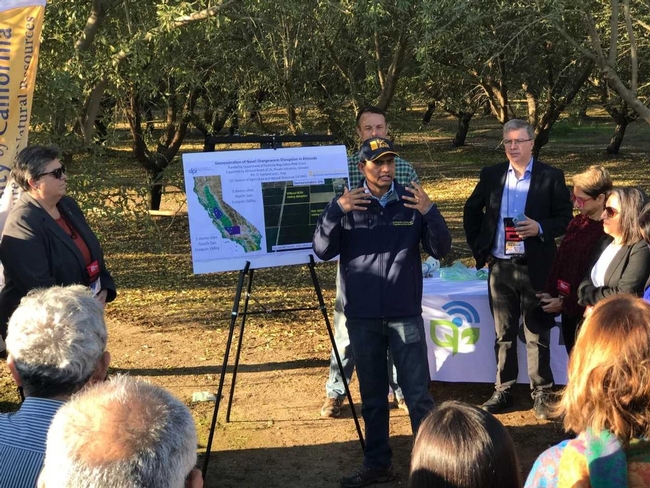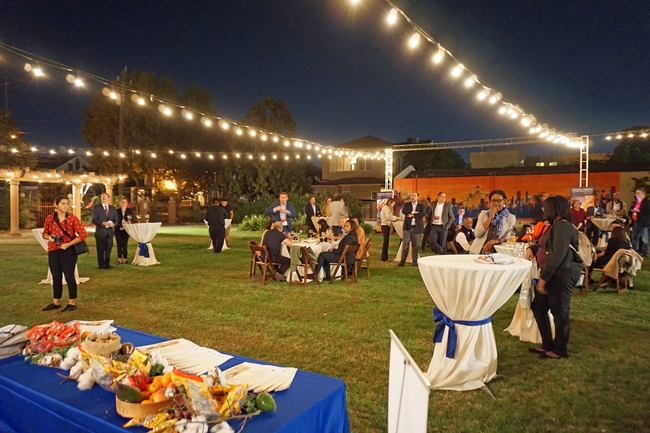Posts Tagged: Stephanie Rill
UC ANR to launch fourth annual #GivingTuesday campaign Nov. 27
On Nov. 27, ANR is once again participating in #GivingTuesday—a 24-hour global giving challenge—a movement about ordinary people coming together to do extraordinary things. Celebrated on the Tuesday after Thanksgiving, #GivingTuesday kicks off the charitable season. For ANR, Giving Tuesday is an opportunity to raise funds for UC Cooperative Extension county programs, research and extension centers and statewide programs. To help Californians recover from recent wildfires, adapt to climate change and escape persistent pockets of poverty, the needs in the coming year will be great, and year-end giving is an opportunity for donors to assist.
“UC Cooperative Extension professionals have a deep passion for their work and a dedication to the communities they serve. While most deliver their research and programs quietly every day, it is especially incredible to witness their response to disaster; for example, recent wildfires saw local UCCE offices responding immediately with vital information for coping with the fires, care for livestock and pets, as well as service in food banks and other volunteer needs,” said VP Glenda Humiston.
UC Cooperative Extension staff and 4-H members took care of evacuated farm animals at the fairgrounds, and in Siskiyou County, partnered with local agencies to create and distribute Pet Emergency Evacuation Plan pamphlets.
“Giving Tuesday gives us an opportunity to talk about our research and outreach to enhance food systems and create thriving communities, as well as all the other positive things everyone in ANR is doing to make life better for Californians,” Humiston said.
For UC ANR stakeholders, #GivingTuesday presents an opportunity to support the many programs and services that strengthen California communities each day and more importantly, during times of crisis. Last year, over $76,000 was raised on #GivingTuesday to support UC ANR programs including the 4-H Youth Development Program and UC Master Gardener Program.
“As residents of California, we're all each other's neighbors—we lend a helping hand, we share information, we care about our community. That's what our #GivingTuesday #NeighborCA campaign is all about.” said Emily Delk, director of annual giving for UC ANR.
“This year, I'm excited to share that we will have two match challenge funds. One supporting the California 4-H Foundation and one for all UC ANR.” said Delk.
A website is up with links to all of ANR's programs, Research and Extension Centers and UCCE offices: ucanr.edu/givingtuesday. It invites donors to designate programs or locations to which they wish to donate.
The website contains a toolkit for county offices and programs to participate. It includes:
- Sample tweets and social media posts
- Custom images to include in social posts
- Templates for “unselfies.” Donors may take photos of themselves holding an unselfie sign and share on social media how they are giving.
The UC Master Gardener Giving Tuesday website is at http://mg.ucanr.edu/givingtuesday.
The 4-H Youth Development Program also has its own website at http://4h.ucanr.edu/GivingTuesday.
Although not as well-known as the shopping events Black Friday and Cyber Monday, #GivingTuesday appeals to people who are swept up in the spirit of giving at the end of the year.
This year Development Services has set a goal of collecting a total of $100,000 for 4-H and UC ANR from 300 or more donors on #GivingTuesday. Last year UC ANR and 4-H received nearly 300 gifts.
“The #GivingTuesday #NeighborCA campaign is a fun way for people in all ANR programs to give to the programs most important to them,” said Delk.
Cybersecurity and UCPath to change the way ANR does business
When ANR joins UCPath in the spring, it will introduce new technology that will ultimately unify and standardize payroll, benefits and human resources systems for all UC employees. As we adopt new technology to modernize ANR business systems, we are strengthening our online security measures.
In a recent webinar to prepare ANR office managers and others for the transition to UCPath in the spring, John Fox, Human Resources executive director, brought in Dave Krause, manager of web development and applications programming, to discuss multi-factor authentication to access online systems, and Emily LaRue, associate director of the Business Operations Center, to discuss the impact of UCPath on the Business Operations Center.
Multi-factor authentication
To use an online system that is operated by UC Davis for ANR, such as the time reporting system, KFS, Aggie Buy or AggieTravel, an ANR employee logs into a form. Historically, once your credentials are “authenticated” against a database hosted by UC Davis, you are redirected to the system and off you go. Another step is being added to protect the system from hackers. A tool called “Duo” will ask you for a second form of authentication.
“Duo seamlessly adds this second form of authentication right in the login form,” Krause said. “For this example, I have preset Duo to send the second authentication to my phone as a 'push notification' (a mobile phone alert that appears onscreen while the phone is still in locked mode). Duo will also happily call you or send you a code to use instead.”
Once the user clicks “approve,” the website immediately accepts the second authentication and opens the site.
Mobile phones, tablets and Apple watches are among the devices supported by Duo. “It doesn't take up much space on your device,” Krause said.
For employees who don't have mobile devices for authentication, physical tokens that connect directly to your computers will be available. Currently, only mobile devices are eligible for enrollment. More information about tokens will be available soon.
If you lose or forget your device or token, UC Davis IET Express help desk can send you a temporary access code.
UC ANR will be rolling out Duo for its identity management system next year. Volunteers, affiliates and collaborators will have unchanged access.
“We are now inviting all UC ANR employees who use UC Davis systems to enroll in Duo via a smartphone or tablet,” Krause said. “Be sure you use a device that is with you when you work!”
For details on Duo enrollment and setting it up, go to http://ucanr.edu/mfa.
Impact of UCPath on Business Operations Center
Becoming its own business unit with UCPath will increase ANR's visibility as equivalent to the 10 campuses and change its business relationship with UC Davis. In addition, ANR's responsibility for compliance and accountability will take on even greater importance. Implementation of UCPath will create some changes to ANR's Business Operations Center, including the location of ANR's UCPath payroll team, work assignments and responsibilities, and systems and processes.
“For the first several weeks, everything will seem different!” LaRue said.
Personnel action entry functions for new hires, terminations and pay changes will be performed by ANR HR or the UCPath Central Team. A single ANR BOC Payroll unit composed of a payroll manager and three staff members will be located in Davis. The BOC will be responsible for audits and additional reporting and there will be new terms, different business processes, and different routing of forms and documentation.
LuRue expects the following to remain the same:
- Payroll (time and leave reporting) processing
o Timely submission for all organizational units
o Time Reporting System review and corrections as needed
- Service level
o ANR UCPath Hypercare Team – Group devoted to resolution of ANR employee issues
- Processing of financial transactions
o BOC-Kearney – UCCE (Gifts excluded)
o BOC-Davis – Statewide programs, Research and Extension Centers and administrative units
For more information about UCPath changes, visit the website at https://ucanr.edu/ucpath.
Names in the News
Jones named UCCE forestry advisor
Michael Jones joined UCCE on Oct. 1, 2018, as the area forestry advisor in Mendocino, Lake and Sonoma counties. He specializes in forest entomology with a focus on forest health and integrated pest management of invasive and endemic forest pests.
Jones completed a Ph.D. in entomology from State University of New York, College of Environmental Science and Forestry and a B.S. in environmental biology and management from UC Davis.
Prior to joining UCCE, Jones was a graduate student and research project assistant at State University of New York. He developed and maintained research projects on delimitation, management, and biological control of the invasive forest pest emerald ash borer in New York. From 2010 to 2013, Jones was a research associate in the UC Davis Department of Entomology, in collaboration with the US Forest Service, Forest Health Protection in Southern California. He participated in a variety of forest pest research projects involving the detection, evaluation and management of endemic and invasive forest pests. He has been active in leading training activities for land managers and land owners in the field identification and management of forest pests, and training and supervising field crews in the collection of field data. As an undergraduate at UC Davis, he worked on sudden oak death with David Rizzo's lab group in the Department of Plant Pathology.
Based in Ukiah, Jones can be reached at (707) 463-4495 and mjones@ucanr.edu.
Sanchez named UCCE woody biomass specialist
Daniel Sanchez joined UCCE on Sept. 1, 2018, as a UC Cooperative Extension specialist in woody biomass utilization in the Department of Environmental Science, Policy & Management at UC Berkeley. Sanchez is an engineer and energy systems analyst studying the commercialization and deployment of energy technologies that remove CO2 from the atmosphere. Sanchez's work and engagement spans the academic, nongovernmental, and governmental sectors. As an assistant Cooperative Extension specialist, he runs the Carbon Removal Lab, which aims to commercialize sustainable negative emissions technologies, and supports outreach to policymakers and technologists in California and across the United States.
Sanchez earned a Ph.D. and a M.S. in energy and resources at UC Berkeley. He completed a B.S.E in chemical and biomolecular engineering at University of Pennsylvania.
Prior to joining the faculty of UC Berkeley, Sanchez was a AAAS Congressional Science and Engineering Fellow serving in the Office of Senator Michael Bennet (D-CO). He has previously held positions with the Advanced Research Projects Agency-Energy, Green for All, and the California Public Utilities Commission.
Sanchez is located in Mulford Hall and can be reached at (215) 593-4493 (cell) and sanchezd@berkeley.edu. Follow him on Twitter @Dan_L_Sanchez.
Larbi named UCCE ag application engineering specialist
Peter Larbi joined ANR on Aug. 13, 2018, as a UCCE area agricultural application engineering specialist at the Kearney Agricultural Research and Extension Center.
Prior to joining ANR, Larbi had been an Assistant Professor of Agricultural Systems Technology in the College of Agriculture at Arkansas State University since 2014. He developed an integrated teaching and research program related to agricultural systems technology; developed and managed research in precision agriculture, agricultural machinery systems, remote sensing and sensor technology; and provided service to the university, college, local community and general scientific community. Larbi held a joint appointment in the Division of Agriculture at University of Arkansas.
From 2012 to 2014, Larbi was a postdoctoral research associate at the Center for Precision and Automated Agricultural Systems at Washington State University. From 2011 to 2012, he was a postdoctoral researcher at the University of Florida Citrus Research and Education Center.
Larbi earned a Ph.D. in agricultural and biological engineering from University of Florida and a M.Sc. and a B.Sc. in agricultural engineering from Kwame Nkrumah University of Science and Technology in Kumasi, Ghana.
Larbi can be reached at (559) 646-6577 and palarbi@ucanr.edu.
Pyle joins Sierra Foothill REC grassland research team
Lysandra Pyle joined ANR on Aug. 15, 2018, as an assistant project scientist. Working closely with project directors at UC Sierra Foothill Research and Extension Center and Eastern Oregon Agricultural Research Center (EOARC), Pyle is leading a multistate research project investigating biotic and abiotic drivers of native grass recruitment on degraded intermountain rangeland and identifying potential management actions that can be used to improve large-scale restoration efforts.
Most of her field work and project development is being done from EOARC, which is in close proximity to the Oregon and California intermountain field sites.
Pyle completed a Ph.D. in rangeland and wildlife resources from University of Alberta, Canada, and a B.Sc. in biology from University of Regina, Canada.
Prior to joining ANR, Pyle worked on contracts specializing in biodiversity monitoring and rangeland ecology while finishing a Ph.D. in rangeland and wildlife resources at the University of Alberta, conferred in April 2018. From November 2017 to March 2018, Pyle was a vascular plant technician with Alberta Biodiversity Monitoring Institute (ABMI) at the Royal Alberta Museum. There, she identified vascular plants collected by ABMI technicians during the field season and contributed to publications.
Pyle also consulted as a plant community data analyst at Manitoba Forage and Grassland Association from January 2017 to March 2018, where she analyzed plant community data collected from the Aspen Parkland and Assiniboine Delta rangeland ecoregions, identified reference communities, and determined how they transition with disturbances such as grazing.
Her Ph.D. characterized the composition and diversity of grassland seed banks in two main studies: identified the diverse disturbance legacies and management histories of pastures on plant communities, seed banks, soils, and rangeland health, and examined legacy effects of pipelines on seed banks and biological soil crusts in native mixed grass prairie.
Pyle is based in Burns, Ore., and can be reached at (306) 551-1108 and lapyle@ucanr.edu. Follow her on Twitter at @GrasslandNerd.
Caeton named UCCE 4-H advisor
Nathaniel Caeton was promoted to 4-H youth development advisor for Shasta, Tehama and Trinity counties on Aug. 1, 2018.
Prior to accepting his current position as 4-H youth development advisor, Caeton had served as the 4-H community education specialist since 2013. He was responsible for overseeing the daily operations of the 4-H Youth Development Program in Shasta and Trinity counties. During that time, he worked diligently to strengthen existing program relationships, while developing new relationships through outreach and collaboration. His master's work at CSU Monterey Bay combined multiple disciplines and built knowledge in the areas of learning theory, instructional design, instructional technology, interactive multimedia, assessment and evaluation. This enabled Caeton to plan, design, develop, implement and evaluate instructional programs. This work culminated in the creation of an electronic portfolio and capstone project, which involved the design and development of a one-hour e-learning module on diversity awareness for adult volunteers. He also actively volunteers with the Boy Scouts of America and the Civil Air Patrol.
Caeton earned an M.S. in instructional science and technology from CSU Monterey Bay and a B.A. in social sciences from CSU Chico.
Based in Redding, Caeton can be reached at (530) 224-4900 and nwcaeton@ucanr.edu.
Mahacek inducted into National 4-H Hall of Fame
Richard Mahacek, UC Cooperative Extension 4-H youth development advisor in Merced County from 1976 to 2012, was inducted into the National 4-H Hall of Fame on Oct. 19 for his lifetime achievements and contributions to 4-H.
Mahacek was one of 15 people inducted during the ceremony at the National 4-H Youth Conference Center in Chevy Chase, Md.
“We are proud to recognize the 2018 National 4-H Hall of Fame honorees for the passion, dedication, vision and leadership they have shown toward young people during their many years of service to 4-H,” said Jeannette Rea Keywood, National 4-H Hall of Fame Committee chair.
Mahacek joined a 4-H Club in Sonoma County when he was 10. During his 35-year 4-H career, Mahacek placed an emphasis on mechanical sciences and engineering projects. His work included development of curricula and activities in science processes, robotics, computers, GIS/GPS, bio-security and environmental issues, such as watersheds and wildlife habitats.
In 1988, Mahacek was a member of the team that developed the 4-H SERIES (Science Experiences and Resources for Informal Educational Settings) curriculum, which was funded by the National Science Foundation and Kellogg. SERIES was the first comprehensive pragmatic science education curriculum to join 4-H's traditional projects. In 2004, Mahacek served on the national leadership team for 4-H SET (Science, Engineering and Technology), a program that succeeded SERIES. Now known as STEM (Science, Engineering, Technology and Math), the project aims to enhance young people's interest in developing the knowledge and skills needed for the 21st century's technically oriented careers.
The crowning achievement of his career was the development of the 4-H Junk Drawer Robotics curriculum in 2011. The curriculum shows how to engage children in building robotic devices with rubber bands, Popsicle sticks, medicine dispensers and bamboo skewers – the kinds of things people already have around the house. The robotics program develops skills that go beyond science and engineering. The children learn communications, teamwork and critical thinking.
Junk drawer robotics is one part of a three-track robotics curriculum. The other tracks are virtual robotics, in which participants build virtual robots on computers, and robotics platforms, which employs commercial robot building kits for materials. The package of robotics programs was the No. 1 selling 4-H curriculum in the nation in 2011. Mahacek was also a driving force in the community in founding the UC Merced Engineering Service Learning Program Castle Science and Technology Center. This facility used a former US Air Force facility to provide hands-on science experiences to the youth of the county.
Mahacek received many honors for his contributions to 4-H and UC Cooperative Extension. In 1988, he received distinguished service awards from the state and national 4-H associations. The Merced County Farm City Ag Business Committee presented him its Agri-Education Award in 1992. Mahacek received the “Hands-On Heroes Award” at the Merced County Children's Summit.
Mahacek said the 4-H program has evolved during his tenure, but it has not changed its core objectives.
“We went from being a predominantly ag program to including many other topics. Our members used to live in just rural settings, but now they come from the suburbs and urban neighborhoods,” Mahacek said. “But we're still promoting the concept of working together and gaining confidence by learning practical skills.”
The National 4-H Hall of Fame honorees are nominated by their home states, National 4-H Council, the National Association of Extension 4-H Agents or 4-H National Headquarters/National Institute of Food and Agriculture based upon their exceptional leadership at the local, state, national and international levels.
Wilen recognized for contributions to nursery industry
Cheryl Wilen, area IPM advisor based in San Diego County, was presented the Research Award by the California Association of Nurseries and Garden Centers (CANGC) for her contributions to the nursery industry at the CANGC Convention in San Diego on Oct. 10, 2018.
“This award acknowledges Dr. Wilen's many significant contributions over her career that have benefited the California nursery and landscape industry,” said Loren Oki, UCCE environmental horticulture specialist in the Department of Plant Sciences at UC Davis and co-director of UC's Nursery & Floriculture Alliance, who presented the award to Wilen.
Wilen specializes in Integrated Pest Management (IPM) for ornamental plant production and maintenance in nurseries, greenhouses, field production, floriculture, turf and landscape, which has resulted in the use of pesticides in a more prescriptive manner and the development of alternative strategies to more efficiently control pests of ornamental plants. Although her primary research focus is the management of weeds, snails and slugs, her other areas of research include the Asian citrus psyllid, disease management in floricultural crops, nematode management in tomatoes, invertebrate pest management in nurseries, vertebrate pest management, mitigating pesticide contamination in surface water runoff, and soil solarization.
Wilen also recently received the UC ANR Distinguished Service Award for leadership. She has served ANR as the acting and interim director of the Statewide UC IPM Program, leader of the Endemic and Invasive Pest and Disease Strategic Initiative, member of Program Council, organizer of the Pest Management Coordination Conference, chair of several UC ANR search committees, and chair and member of the South Coast Research and Extension Center Research Advisory Committee.
Her current and previous professional service includes chair of the Basic Science Section Western Society of Weed Science, chair of Teaching and Technology Transfer Section Weed Science Society of America, chair or co-chair of meetings of professional organizations including the California Weed Science Society, and has served or is currently serving as a member of various committees of the Weed Science Society of America, Southern California Chapter of the California Association of Pest Control Advisers, Steering Committee of the 2015 International IPM Symposium, and the CANGC Research Advisory Committee.
The CANGC Research Award recipient is selected by their peers and colleagues from industry and academic community.
4-H teams bring home NAE4-HA awards
Katherine Soule, UC Cooperative Extension director and youth, families and communities advisor for San Luis Obispo and Santa Barbara counties, and community educators Janelle Hansen, Andrea Hollister, Laura Pena, Dagmar Derickson, Shannon Klisch, Melissa LaFreniere, Yezenia Romero, Yudilia Tomsen, Miguel Diaz, Betsy Plascencia, JaNessa Willis and Lisa Paniagua won the Excellence in Healthy Living Programming Award for the Western Region. The team also won the NAE4-HA Excellence in Healthy Living Programming for California. The Excellence in Healthy Living Programming Award recognizes outstanding efforts and impacts of NAE4-HA members in healthy living programming, evaluation, and/or research projects.
JoLynn Miller, UC Cooperative Extension 4-H youth development advisor for the Central Sierra, won Excellence in 4-H Volunteerism Award for the North Central Region. Miller was part of a team with members from the North Central Region that created the National 4-H Volunteer E-Forum.
At the state level, Kendra Lewis, academic coordinator; Sheila Bakke, 4-H program representative in Solano County; Gloria Gonzalez, 4-H SET program representative, Valerie Williams, 4-H program representative, and Shannon Horrillo, statewide 4-H Youth Development Program director, won the 4-H Military Partnership Award
The purpose of the 4-H Military Partnership Award is to recognize the individual or team who has created a positive Extension image through his/her/their leadership and citizenship as it relates to the development of the 4-H Military Partnerships on U.S. Army, U.S. Air Force, and/or U.S. Navy installations and in the community as it pertains to Reserve Component service members and families.
John Borba, 4-H youth development advisor for Kern County, was honored with the 25 Years of Service Award, Steven Worker, 4-H youth development advisor for Marin, Sonoma and Napa counties received the Meritorious Service Award for service in 4-H programs for 15+ years. Charles Go, UC Cooperative Extension 4-H youth development advisor for Alameda and Contra Costa counties, received the Distinguished Service Award for more than 7 years of service. Go also has begun serving as western regional director on the NAE4-HA Board. Soule received the Achievement in Service Award for 3 to 6 years of service in 4-H programs.
They received the awards Oct. 10 at the National Association of Extension 4-H Agents conference in Columbus, Ohio.
Verdegaal inducted to San Joaquin County Agricultural Hall of Fame
Paul Verdegaal, who retired after serving more than 30 years as UC Cooperative Extension viticulture advisor in San Joaquin County, was inducted into the San Joaquin County Agricultural Hall of Fame on Oct. 18. Donald Rough, who was a UCCE pomology advisor, will be inducted posthumously.
“Verdegaal helped remove the stigma that Lodi could not grow premium wine grapes through exhaustive research, leadership and work with growers,” wrote Bob Highfill, marketing and communications manager for the Lodi Winegrape Commission, in the Stockton Record.
“During Verdegaal's tenure as farm advisor, the grape and wine industry in San Joaquin County flourished. Thirty years ago, there were 43,370 acres of grapes cultivated in San Joaquin County. In 2017, there were close to 100,000 acres. In 1986, Lodi was first recognized as an American Viticulture Area, but many, including the University, still felt that premium wine varietals could not be grown commercially in the Valley. Verdegaal worked hard to change that stigma.”
Kabashima honored with Urban Tree Legacy Award
Kabashima's varied research and extension programs have included the management of insects, diseases, and biological control of exotic and invasive pests.
Kabashima, who retired in 2015 after 28 years of serving the nursery and landscape industry and homeowners in Orange and Los Angeles counties, continues to lead the battle against invasive shot hole borer pests that spread fusarium dieback, threatening trees in Southern California. On Oct. 3, Kabashima gave a presentation at an urban forest summit for public agencies, reviewing current pest concerns relating to trees for San Diego County and what the county needs to do to defend against future invasions.
He has provided testimony for the California Legislature to fund further research into these destructive pests. In January, Kabashima was instrumental in bringing together university scientists, federal and state government representatives, county agricultural commissioners and nonprofit organization leaders for a summit in the state capitol to coordinate their efforts to battle invasive pests.
Kabashima received his bachelor's degree in agricultural biology from Cal Poly Pomona, master's degree in pest management from UC Riverside, an MBA from Pepperdine University and a doctorate in Entomology from UC Riverside. In 2014, he was inducted into the Green Industry Hall of Fame, and in 2016 he received the Arboriculture Research Award from the Western Chapter of the International Society of Arboriculture.
Communication is key to action on California’s new water narrative
UC scientists, students and water agency professionals took a critical look inwards and a radical look outwards when they gathered in Sacramento in October to reimagine California water.
The event was the fourth annual gathering sponsored by UC ANR's California Institute for Water Resources and the University of California Water Security and Sustainability Research Initiative, UC Water.
While science is the hallmark of a research-oriented institution like UC, the participants were asked to recognize their important role not just as scientists but also communicators.
“We have a big role in educating the public,” said Roger Bales, engineering professor at UC Merced who has been active in water and climate research for more than 30 years. “Scientists are political actors. Facts do not speak for themselves.”
Felicia Marcus, chair of the California Water Resources Control Board and a conference panelist, asked the scientists to make their work accessible, and if they are uncomfortable with plain language, “write it both ways.”
“Complexity can lose people easily,” she said.
The conference keynote speaker, futurist Kim Stanley Robinson, also addressed the divide between scientific discourse and popular understanding, in particular when speaking about climate change.
“There is a strange disconnect between what the scientific community is telling the world and what the world is hearing. As a result of data analysis, science is announcing to the world there is climate change. Individuals cannot perceive climate change,” he said. “Show them in ways that can be understood by the senses. The story has to be told with pragmatism and common sense.”
The Reimagining California Water Conference pursued the water journey from the high-mountain headwaters of the Sierra Nevada to the vast groundwater basins in the valleys below. Over the last century, the mountains were blanketed with snow each winter, storing water that melted slowly in the spring and summer to provide a reliable source of water for farming and communities below. However, climate change is telling a new tale. Warmer weather means less snow and more rain will fall on the mountains during the winter. The quick runoff must be managed in a way that preserves it for use in the summer.
“We need groundwater recharge because we're losing the snow pack quicker than we thought we would,” Bales said.
The new California water narrative has prompted scientists and policymakers to take a serious look at the potential for “flood-managed aquifer recharge” or Flood-MAR. Flood-MAR is a management strategy that uses water from rain or snowmelt to flood agricultural lands and working landscapes, such as refuges, floodplains and flood bypasses.
Successful implementation of Flood-MAR requires the identification of land for groundwater recharge, understanding the economic and agronomic impact of using agricultural land for recharge, and impacts of high-volume recharge on groundwater quality. But the potential is enormous.
“The state's underground basins are capable of storing 500 million acre-feet of water,” said Graham Fogg, UC Davis professor of hydrogeology. “That's like 500 Folsom reservoirs.”
Though the enormity of rewriting the California water story might seem an insurmountable challenge, panelist Debbie Franco noted that the passage of Sustainable Groundwater Management in 2014 happened when the state's unsustainable reliance of groundwater spiked during the 2011-2016 drought, reducing municipal water quality, drying domestic wells and causing land to sink.
“What seems impossible, after four years of drought, can be possible,” Franco said. “What will be the next thing? Get a sense of the solutions now.”
Tenth Americas Competitiveness Exchange tours N. California technology centers
Vice President Glenda Humiston hosted 50 high-level representatives from 24 countries as part of the Tenth Americas Competitiveness Exchange (ACE 10) on Innovation and Entrepreneurship tour of Northern California Oct. 21-27.
Over the course of a week, ACE 10 participants visited innovation clusters in San Francisco, Salinas, Santa Cruz, Monterey, Fresno, Davis and Sacramento.
UC Cooperative Extension advisors David Haviland and Jhalendra Rijal and Sebastian Silva of ag tech company Semios talked to the international delegates about almond research and how UCCE works with growers and companies.
Later, an entrepreneur told AVP Wendy Powers that he was beginning to think about how to develop a university-based Extension system in Grenada, how to convince his government to redirect funds from federal agencies to the university.
Tour co-sponsor Valley Vision's Tammy Cronin described activities during the ACE 10 visit to Sacramento in a blog post.
The ACE program is coordinated by the U.S. Department of Commerce's International Trade Administration and Economic Development Administration in coordination with the U.S. Department of State and the Organization of American States. It brings together decision-makers from around the world to explore global and regional partnerships, and economic development opportunities to establish new global commercial relationships.
“ACE has been instrumental in showcasing the incredible innovation capacity of U.S. regions and has proven critical in establishing global commercial relationships that can support U.S. business objectives,” said Dennis Alvord, EDA deputy assistant secretary for regional affairs. “Northern California is a world-renowned center of innovation and entrepreneurship activity and we look forward to showcasing the incredible work that the Department of Commerce and regional leaders are doing to advance the innovation economy.”
EDA and OAS posted daily updates about the tour on Facebook and Twitter with the hashtag #ACXchange.



